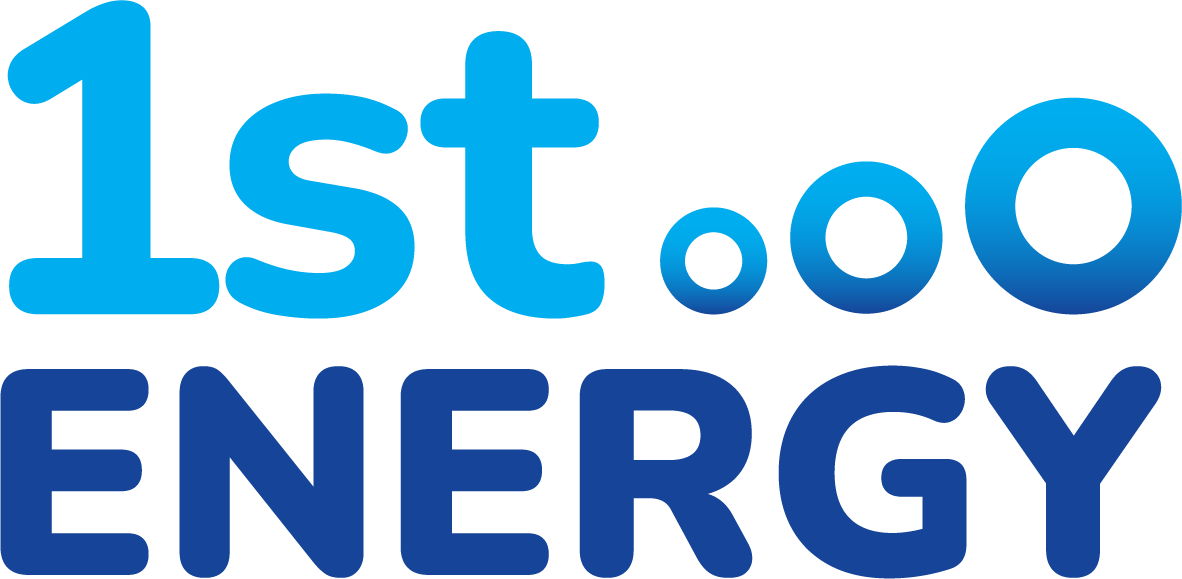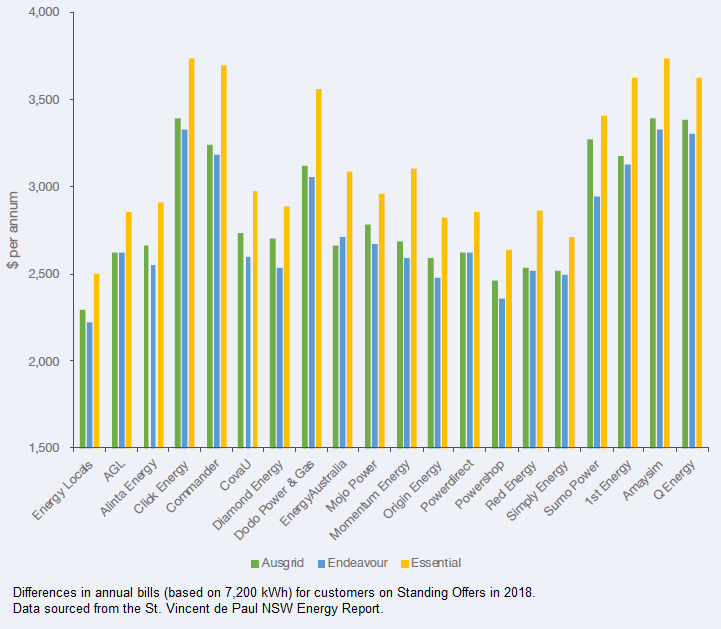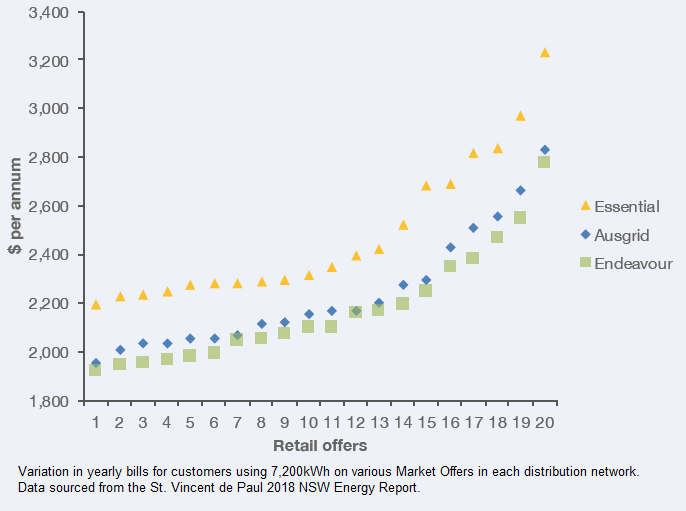Compare Energy Plans NSW
Post on June 22nd, 2021
Get an accurate electricity comparison in Sydney and NSW
Undertaking an electricity comparison in Sydney and New South Wales is a challenging task. While the New South Wales electricity market is heavily scrutinised by the government-run AER, it is perhaps one of Australia’s most confusing markets to fully grasp and understand with so many distributors and retailers operating within the state.
It helps to first understand the basics of the electricity market, before you look into an electricity comparison. In NSW, three distributors maintain the network and supply electricity to homes and businesses. These are the companies that maintain the poles and the wires, and are responsible for fixing the faults. The NSW electricity distributors are:
For each distributor, each household and business will have a different tariff and a different rate structure depending on the type of meter. Various retailers operate within each distribution area. Each of these retailers will have their own plans with different rates for peak, shoulder, or off-peak usage as well as various discounts and other pricing arrangements.
How to compare electricity and gas suppliers currently in NSW and Sydney
Before you compare electricity providers and gas suppliers, it helps to start with the basics so you can understand the differences between the rates and plans offered by each supplier. Let’s start by looking at your bill, so you can understand the difference in what each supplier is likely to charge you for.
Understand your Electricity Charges
Your electricity bill is made up of two main costs – the usage charge and the supply charge. These rates can vary dramatically depending on where you live, and the unfortunate truth is that residents closer to Sydney are charged less for their electricity use than residents in rural NSW. This is due to the increased costs of supplying electricity to rural areas.
The supply charge is the fee you pay to be connected to the grid. This fee will normally stay around the same every bill (unless your supplier changes their pricing). This “service to property” fee is charged in cents per day. Keep in mind too that if you see a plan that has a surprisingly low supply charge, this will generally be offset by a higher usage fee.
The usage charge is a fee your retailer charges you for the amount of electricity you use. It is charged in cents per kilowatt hour (you many see it abbreviated on your bill as c/kWh). Your electricity usage rate will vary according to the type of tariff you are on, but is generally made up of peak and off-peak usage charges.
Understand your Electricity Tariffs
Your tariff should be shown on your bill. If not, give your supplier a call to find out the type of tariff you’re on. Once you know this, you’ll be able to compare other rates and plans to see if you’re able to save money.
In addition to the usual Time of Use and Single Rate tariffs, the introduction of new electricity retailers to the market has seen new plan structures with different types of tariffs.
What are Time of Use Tariffs? A time of use tariff means you’ll get charged different rates depending on the time of day you use you electricity. This usually means higher rates during peak times (the afternoon and evening), slightly lower rates during the shoulder period (early morning), and then lower rates during off-peak times (generally overnight)’
What is a Single Rate Tariff ? A single rate tariff means one set rate for your usage, no matter the time of day or night you’re using your electricity. These are generally higher than other tariffs and are less common with the introduction of smart meters.
What is a Controlled Load Tariff? Controlled load tariffs apply to single appliances that generally have their own electricity meter. Things like electric hot water systems, underfloor heating, and your pool pump are likely to be on a controlled load tariff. If controlled load tariffs are available, they will often be significantly lower than other usage rates.
What are Block Rate Tariffs? Some companies will offer electricity in ‘blocks’ of a certain amount of kilowatt hours per day or per billing cycle. For example, you may be charge one rate for your first 1,000kWh each quarter, and a different rate for subsequent blocks.
What is a GreenPower Tariff? Many electricity retailers are beginning to offer Green Energy plans which allow consumers to choose carbon offsets or renewable energy generators. These plans typically allow users to choose to have between 10% to 100% of their supplied energy generated from renewable energy sources like wind, hydro, or solar. This means that customers pay a few cents extra per kWh depending on the amount of sustainable energy they want to use.
What are Feed-in Tariffs? These rates only apply to customers with solar panels who might receive a small credit on their bill for each kWh of electricity their solar system delivers back to the electricity grid.
Understand your Electricity Plan
Knowing what type of plan you’re on will help you work out if it’s the right plan for you. Understanding the range of plans on offer from the different companies will help you decide if you should switch companies or change plans for a better deal. The main types of energy plans available are: fixed rate plans and variable rate plans.
What is a Fixed Rate Plan? A plan with a fixed rate will not change over the length of your contract. This means you’ll always be charged at the same usage rate with only the amount of electricity you use determining your quarterly power bill. This can mean big savings if you’re prepared to sign up for a 1 year or 2 year contract. Not all companies offer fixed rate plans, and not all consumers are happy to be locked into a long-term contract.
What is a Variable Rate Plan? Most retail market plans come with a variable rate. This means the rate your retailer charges you for the electricity you use can vary according to wholesale energy prices and even at your suppliers’ discretion. These are the usual types of plans you’ll find, so these are where you can see the most savings, when shopping around. Exit fees can apply to both fixed rate and variable rate plans.
Understand the Difference between Standing Offers and Market Rates
When you compare electricity providers, you’ll know that all electricity companies will offer a standard, non-discounted plan, with many also offering a range of more competitive market offers which may appeal to different customers for different reasons.
What is a Standing Offer? The default pricing structure published by energy retailers is usually their highest priced plan. If you were automatically allocated to an electricity company when New South Wales was deregulated, you would have been placed on a standing offer.
Default Standing Offers vary greatly across the different electricity networks and between electricity companies. In NSW, 26% of customers have not taken the time to switch to a better market deal, and these customers are paying far too much for their electricity.
The 2021 Tariff Tracking project found that a household in NSW using an average of 9,200kWh per annum would save between $550 to $900 a year (depending on their network area) if they switched from the default retailer’s standing offer to the best market offer.
What is a Market Rate? Because of increased competition in the electricity industry, market offers have the potential to deliver huge savings. These rates tend to offer a range of discounts depending on payment methods, paying on time, bundled energy, or a range of other options. Energy users will find there’s often a difference of several hundred dollars between a company’s Standing Offer and their best Market Rate.
Request a Callback Compare Now
Compare Electricity Suppliers
There are a huge number of energy retailers to compare in Sydney and NSW including:
- 1st Energy
- AGL
- Alinta Energy
- Click Energy
- Diamond Energy
- Dodo Power and Gas
- Energy Australia
- ERM Power Retail
- Lumo Energy
- Mojo Power Pty Ltd
- Momentum Energy
- Next Business Energy
- Origin Energy
- Powershop
- QEnergy
- Red Energy
- Simply Energy
The various plans and market rates offered by these suppliers constantly changes. In 2018 – 2021, the Tariff Tracking project found a huge variation in offers across each network in NSW. Consumers that shopped around had the chance to pay far less on their yearly bills.
Going through all these suppliers to find one that suits you might seem like a daunting task. But it doesn’t have to be. Electricity Wizard monitors changes in the various market rates and usage charges to make sure our customers get access to the best deals. By comparing electricity providers and looking to see what plans offer the best benefits to suit your circumstances, you can start to save on your energy bills.
Get in touch with Electricity Wizard today
We’ll help you get a smarter, easier electricity comparison in Sydney and NSW. Save time and money by letting the experts find you the best plan from recommended electricity companies to suit you. Electricity Wizard will compare your electricity company and find you the cheapest electricity prices in NSW.
Call Electricity Wizard now on 1300 359 779 or fill in the form, and we’ll call you straight back.






 Compare Plans Online
Compare Plans Online Residential
Residential

 Business
Business

 Moving House?
Moving House? Helpful Energy Info
Helpful Energy Info  Free Service
Free Service










 Related Articles
Related Articles